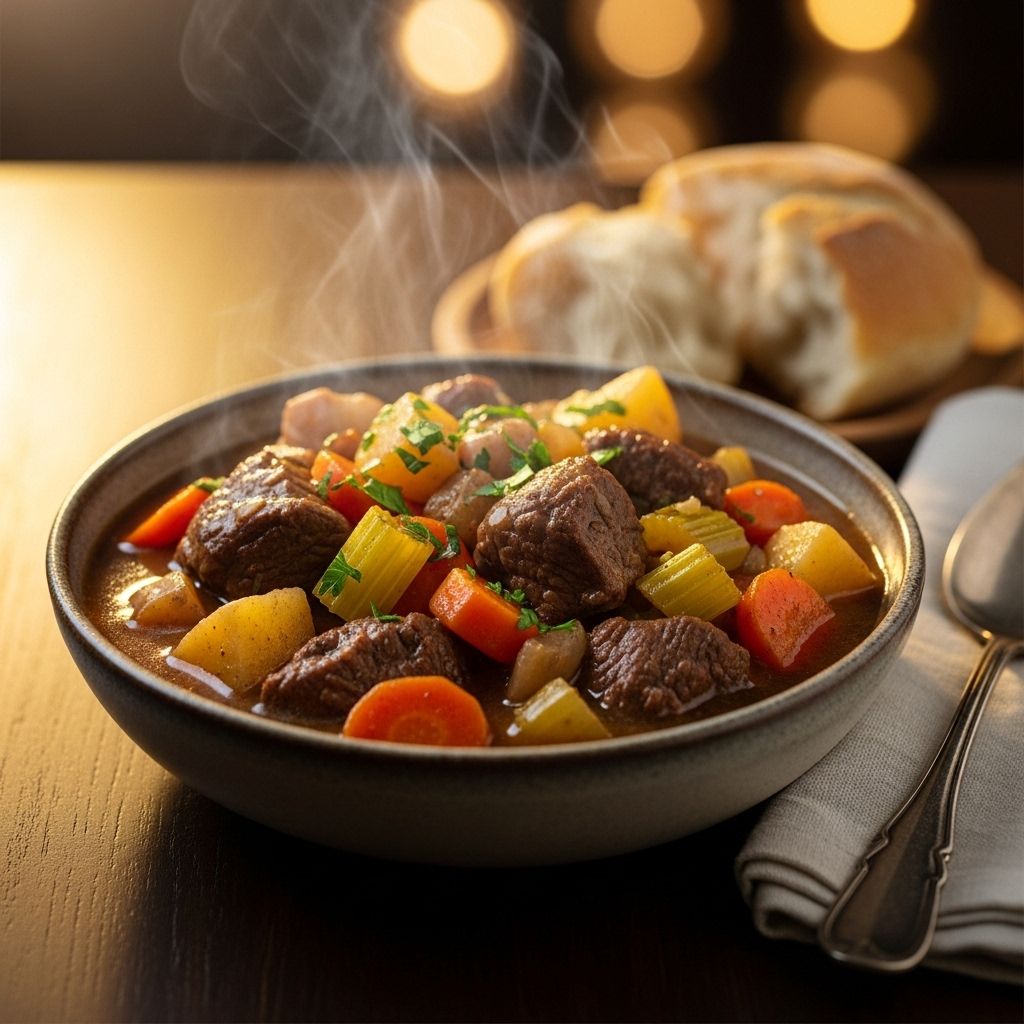All-American Beef Stew: Expert Techniques For Classic Comfort
Discover browning, braising, and seasoning tips for a deeply savory and rich bowl.

All-American Beef Stew: The Ultimate Guide to Classic Comfort
Few dishes epitomize American home-cooked comfort like a steaming bowl of beef stew. The All-American beef stew is defined by tender beef morsels, soft potatoes and carrots, and a deeply savory sauce that achieves a magical combination of richness, sweetness, and umami. Achieving perfection in this dish isn’t just about following a recipe—it’s about applying key techniques at every stage. This comprehensive guide walks you through every element for consistently delicious results, drawing on the science and art that make beef stew a must-have for chilly nights or cozy family gatherings.
Why This Recipe Works
- Flavor Layering: Browning the beef and vegetables at distinct stages builds complexity.
- Controlled Braising: Using both stovetop and oven ensures even heat, tenderizing the meat without overcooking vegetables.
- Umami Boosters: Tomato paste, soy sauce, and anchovies deepen the savory base without overwhelming the stew’s classic profile.
- Vegetable Timing: Adding vegetables in stages yields perfect textures for carrots, potatoes, and aromatics.
- Starch Management: Strategic use of flour thickens the sauce and adds body without muddiness.
Table of Contents
- Essential Ingredients
- Key Equipment
- Step-by-Step Guide
- Technique Tips and Variations
- Serving Suggestions
- Troubleshooting & Pro Tips
- Frequently Asked Questions
Essential Ingredients
Every ingredient in this stew plays a role beyond mere tradition. Here’s a breakdown of what you need and why:
| Ingredient | Purpose |
|---|---|
| Chuck Roast | Rich flavor and an ideal fat/collagen ratio for braising; yields fork-tender results. |
| Carrots | Slight sweetness and color; texture must be managed for doneness. |
| Potatoes (Yukon Gold) | Keep shape throughout braising and add subtle creaminess. |
| Onions | Sweetness and body for sauce when browned and simmered. |
| Celery | Classic aromatic note balancing richness. |
| Tomato Paste | Concentration of sweetness and umami with mild acidity. |
| Garlic | Savory depth; blooms when sautéed in fat. |
| Beef Stock | Builds the stew’s saucy foundation; choose low sodium for control. |
| Red Wine | Optional. Adds acidity and complexity—substitute water or additional stock for complete American flavor. |
| Worcestershire Sauce | Brightens and amplifies savoriness with umami-rich ingredients. |
| Soy Sauce | Not traditional, but a small amount boosts savory depth and color. |
| Anchovies | Provide massive umami impact; melt away without leaving a fishy taste. |
| Fresh Herbs (Thyme, Parsley, Bay Leaf) | Classic flavors for brightness and freshness. |
| Flour | Thickens the sauce and helps brown meat. |
| Vegetable Oil | High-heat cooking fat for browning; can blend with butter for flavor. |
| Kosher Salt & Pepper | Essential for seasoning at every stage. |
Key Equipment
- Large Dutch Oven: Enamel or cast iron ensures even heat, good browning, and a perfect vessel for oven braising.
- Wooden Spoon: For scraping fond and gently stirring without damaging meat or vegetables.
- Sharp Knife and Cutting Board: Helps with even meat and vegetable cuts.
- Tongs: Safe handling of hot, browning beef cubes.
- Measuring Cups and Spoons: For precise proportions of liquids and seasoning.
Step-by-Step Guide: How to Make the Best Beef Stew
1. Cutting and Prepping
- Trim excess fat from beef chuck and cut into 1.5-inch cubes. Pat dry thoroughly—moisture is the enemy of browning.
- Peel and cut carrots and potatoes into likewise-sized chunks for even cooking.
- Chop onions and celery; mince garlic and anchovies.
2. Building Flavor: Browning the Beef
The key to rich stew is encouraging the Maillard reaction—deep chemical browning that creates roasted, meaty flavors:
- Heat oil in Dutch oven until shimmering. Add beef in batches, spacing well. Brown deeply on at least two sides (allow 3–5 minutes per side).
- Transfer browned beef to a large bowl; repeat with remaining meat.
- Do not rush—this builds a foundation of flavor for the stew’s sauce.
3. Sautéing Aromatics & Creating a Savory Base
- Lower heat; add chopped onions and celery with a pinch of salt. Cook, stirring often, until browned and softened.
- Stir in tomato paste and cook until darkened—this intensifies sweetness and umami.
- Add minced garlic and anchovies, sautéing just until fragrant.
4. Deglazing & Simmering
- If using wine, pour in and scrape up browned bits (fond) from the bottom. Let alcohol cook off for 1–2 minutes.
- Return beef (and accumulated juices) to the pot.
- Add beef stock, Worcestershire, soy sauce, and herbs (tie thyme/bay in a bundle for easy removal). Bring to a simmer.
5. Oven Braising
- Cover partially with a lid. Transfer Dutch oven to the lower-middle rack of a preheated oven (approx. 300°F/150°C).
- Braise for about 90 minutes, then test beef—it should be starting to soften, but not fall apart.
6. Adding Vegetables for Perfect Texture
- Add potatoes and carrots to the stew, stirring gently. Return to oven and continue braising for another 45–60 minutes until beef is fork-tender and vegetables are just cooked through.
- Remove herb bundle. Taste and adjust seasoning with more salt, pepper, or acid (sometimes a splash of vinegar or Worcestershire brightens the finished dish).
7. Thickening and Finishing
- If sauce is too thin, simmer uncovered on the stovetop, stirring, until volume concentrates and sauce thickens.
- For silky sauce, mash a few potato or carrot pieces into the broth and stir.
- Sprinkle with chopped fresh parsley before serving for brightness.
Technique Tips & Variations
- Don’t overcrowd the pan when browning: Meat steams instead of browns if crowded, reducing depth of flavor.
- Keep the lid slightly ajar: Encourages evaporation and thickens sauce.
- Braises benefit from rest: Stew tastes even better after cooling and reheating the next day; flavors meld and intensify.
- Vegetable variations: Add parsnips, rutabaga, or mushrooms for savory nuance or seasonal flair.
- Make it gluten-free: Substitute cornstarch or a potato starch slurry to thicken if desired.
- Substitute for wine: Use extra stock or water plus a splash of balsamic vinegar for acidity.
- Crockpot variation: Sear meat and aromatics first, then combine all in the slow cooker and braise on low for 8 hours.
Serving Suggestions
- Crusty bread: A warmed, rustic loaf for soaking up the rich sauce.
- Buttered noodles: Spoon stew generously over broad egg noodles for a hearty plate.
- Rice or mashed potatoes: Serve stew over fluffy rice or a mound of mashed potatoes for extra comfort.
- Fresh greens: A simple salad of lettuces in vinaigrette balances the stew’s richness.
Troubleshooting & Pro Tips
- Meat is tough? Braise longer; connective tissue needs time to dissolve. Properly cooked chuck will yield easily under a fork.
- Thin sauce? Simmer uncovered to reduce and thicken, or mash vegetables into the sauce for body.
- Stew tastes flat? Add small dashes of Worcestershire, soy, or a squeeze of lemon vinegar at the end to wake up flavors.
- Too fatty? Skim rendered fat from the surface before serving or refrigerate overnight and remove solidified fat easily.
Frequently Asked Questions (FAQs)
Q: Can I make beef stew ahead of time?
A: Yes. In fact, beef stew improves in flavor when made a day ahead, allowing the flavors to meld and deepen. To serve, gently reheat until fully warmed through.
Q: What’s the best cut of beef for stew?
A: Well-marbled chuck roast is preferred for its balance of lean and fat, which breaks down for a succulent, tender result. Avoid pre-cut “stew meat,” which is often a mix of trimmings that cook inconsistently.
Q: How do I avoid mushy vegetables?
A: Add potatoes and carrots only after the meat is nearly tender to prevent overcooking and mushiness, ensuring vegetables are perfectly cooked.
Q: Is it necessary to use wine?
A: Wine is optional. While it lends acidity and depth, you can achieve excellent results using only beef stock and a splash of Worcestershire or vinegar for brightness.
Q: What makes the stew extra savory?
A: Umami boosters like tomato paste, soy sauce, Worcestershire, and anchovies build layers of deep savoriness without overpowering the stew’s classic character.
Nutrition Information (per serving, approximate)
- Calories: 450–550
- Protein: 32g
- Fat: 20g
- Carbohydrates: 35g
- Sodium: 700mg
Values will vary based on cut of beef and choice of added ingredients.
Beef Stew Variations & Inspiration
- Beef Bourguignon: Use Burgundy-style wine, pearl onions, mushrooms, and bacon for a French twist.
- Guinness Stew: Substitute part of the stock for stout beer; add turnips and fresh thyme for an Irish influence.
- Southwestern: Add roasted green chiles and corn, and season with cumin and smoked paprika for a spicy kick.
- Vegetarian: Replace beef with mushrooms and lentils, using vegetable stock and boosting umami with soy sauce and miso paste.
Storage & Leftovers
- Cool stew to room temperature, transfer to airtight containers, and refrigerate for up to 4 days.
- Stew freezes very well. Portion into freezer-safe containers and freeze for up to 3 months. Thaw overnight in the refrigerator for best results.
Reheat gently on the stove, adding a splash of water or broth as needed to loosen the sauce.
Conclusion
All-American beef stew is much more than a simple weeknight meal—it’s a transformative process built on patience, attention to detail, and an understanding of how each step intensifies the comforting flavors we crave. Whether made for a Sunday family dinner or prepped for a week’s worth of cozy lunches, this beef stew celebrates American home cooking at its finest. Armed with the right ingredients, techniques, and a dash of culinary science, anyone can master the art of this hallowed comfort classic.
References
Read full bio of Srija Burman












